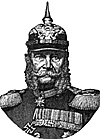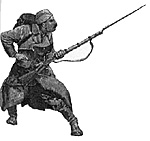 This all began with the thought that by the time I dig out any figures (having already painted them) and set up the terrain, I am fairly limited in time for the actual game. My first thought was to try to do away with need to lay out terrain; given a large stretch of blue carpet, I swung into the naval field. This explains the various Napoleonic naval bits and also led to the idea behind "An Austrian Lake" - so now you now what to blame. Meanwhile a certain Mr Hannam was singing the praises of IT Figures' WWl range. I have always been reluctant to play WWI games - for the usual reasons of taste and the sheer horror of it. My resolve was weakened when I saw the pictures of painted IT Figures Tommies; I also thought that no man's land could be easily recreated with some brown cloth and bits of rolled fuse wire so I bought six Tommies and six Germans. Painted they looked pretty good, the rules were being jotted into the notebook as ideas came, what about terrain? I decided against the cloth - I would have to buy it. Ot came the pizza base, stanley the knife, earth paint, pva glue and sawdust. A lot of mess and sawing later, emerged a homemade version of the pizza base set up marketed by Hovels, with a few bits of polystyrene, glue and stuff in a sort of heap that resembled the lip of a trench. The first effort resembled a railway embankment - my trench sector was thus named Clapham Junction. So, with rebuilt terain and the figures all fitting in a cigar box, I was set. . . . .
This all began with the thought that by the time I dig out any figures (having already painted them) and set up the terrain, I am fairly limited in time for the actual game. My first thought was to try to do away with need to lay out terrain; given a large stretch of blue carpet, I swung into the naval field. This explains the various Napoleonic naval bits and also led to the idea behind "An Austrian Lake" - so now you now what to blame. Meanwhile a certain Mr Hannam was singing the praises of IT Figures' WWl range. I have always been reluctant to play WWI games - for the usual reasons of taste and the sheer horror of it. My resolve was weakened when I saw the pictures of painted IT Figures Tommies; I also thought that no man's land could be easily recreated with some brown cloth and bits of rolled fuse wire so I bought six Tommies and six Germans. Painted they looked pretty good, the rules were being jotted into the notebook as ideas came, what about terrain? I decided against the cloth - I would have to buy it. Ot came the pizza base, stanley the knife, earth paint, pva glue and sawdust. A lot of mess and sawing later, emerged a homemade version of the pizza base set up marketed by Hovels, with a few bits of polystyrene, glue and stuff in a sort of heap that resembled the lip of a trench. The first effort resembled a railway embankment - my trench sector was thus named Clapham Junction. So, with rebuilt terain and the figures all fitting in a cigar box, I was set. . . . .
Objective.
Lurk menacingly across no man's land and grab a few prisoners.
You move from hex to hex, trying not to be spotted. I presume that you start on the edge of one hex and move across, the exact distance in hexes to the enemy trench is up to you.
There are three rates of movement:
Up and moving. This precludes cover or caution. You are not spotted only on a critical success. You have to roll under your EDNA to leave the hex, rolling twice if the hex is wired - one fail and your stuck. A failure reduces EDNA by 1.
Stalking. This is more cautious, allowing cover and you are spotted only if you fail EDNA, there is a +2 on the EDNA roll though. Otherwise as above.
Creeping. Maximum use of cover and concealment, only spotted on a critical miss. There is a +4 on the EDNA roll, rest as stalking.
If you are spotted roll d6:
Adjacent to enemy trench:
- 1 Nothing A
2 Single shot A
3,4 Handgenade B
5,6 MG burst B
Anywhere else :
- 1,2,3 Nothing A
4 Single shot A
5,6 MG Burst
- 1,2,3 A
4,5,6 B
A - not necessarily seen, carry on if you dare; B - spotted, if you want you can call the raid off.
To actually get in to the enemy trench, leave your adjacent hex without being spotted. Then make a straight EDNA roll, succeed and you drop right onto the enemy, fail and you get shot at on the way in. Roll d6 1,2,3 single shot, 4,5 a handgrenade, '6' a burst of MG fire from somewhere.
So, you are in the trench; what do you find?
- 1,2,3,4 there is one man,
5,6 there are two.
The inevitable scuffle ensues. Outnumbered figures may surrender by rolling the odds + 1 on a d6 (eg 3:1 surrenders on 1234). From now on, if using an EDNA based combat system, all the raiders use a separate EDNA, but starting with the EDNA at the point of getting into the trench.
Each turn of melee, or you are in the trench, roll for wandering locals:
- 1,2 none,
3,4 one man,
5 NCO and one man,
6 a bomb is flung into the sap.
Once you have cleared the trench, roll for rummaging:
- 1,2 Nothing,
3,4 jolly good binoculars
4,5 Unit roster or similar
6 Oh dear, a kipping officer with a copy of orders.
If you want to be sadistic, you could replace 1 with a booby trap - treat as grenade.
Random nastinesses
MG bursts: Roll vs EDNA, if fail, take difference in EDNA loss. If moving, roll on 3d6, stalking 2d6, creeping 1d6 (rolling another d6 if the first is a 6).
Single shots: Roll 2d6, lose 1 point of EDNA on 10+ moving, 11+ if stalking, 12 if creeping.
A fusilade: Roll d6 for number of shots.
Grenades: Treat as MG bursts, except if in a trench where the grenade lands outside on a 4,5,6; if it lands inside, roll as if moving.
 To shoot, individual raiders make an EDNA roll, a success causes a duckback and the target freezes next turn. A critical success, or two hits in one turu, puts the figure out of action. The defenders roll a d6, hitting on a 6 and reducing the targets EDNA by 1d6.
To shoot, individual raiders make an EDNA roll, a success causes a duckback and the target freezes next turn. A critical success, or two hits in one turu, puts the figure out of action. The defenders roll a d6, hitting on a 6 and reducing the targets EDNA by 1d6.
Melee, well, you could do worse than use the generic melee ideas or the good old, highest dice wins.
To return to your lines just creep back home using the above rules, using the EDNA of the lowest figure If you creep through the backlots of your Gauntlets, you will find a cunning little article by Mark called "Pinetree Knob Raid" which is full of ideas for trench raiding.
This is a picture of the beach reconnaissance flown prior to D-day. It is from the National Archives and shows the D-day planners clearly what they were up against. Look for Mark Hannam to maybe come up with some good D-day scenarios (I sent him this book)!
Back to The Gauntlet No. 11 Table of Contents
Back to The Gauntlet List of Issues
Back to Master Magazine List
© Copyright 1997 by Craig Martelle Publications
This article appears in MagWeb (Magazine Web) on the Internet World Wide Web.
Other military history articles and gaming articles are available at http://www.magweb.com